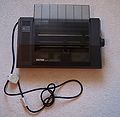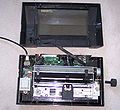Difference between revisions of "Amstrad DMP1 printer"
(→Technical) |
|||
| Line 29: | Line 29: | ||
SW1 dipswitch (accessible on outside) | SW1 dipswitch (accessible on outside) | ||
two fuses | two fuses | ||
| − | |||
| − | |||
| − | |||
| − | |||
| − | |||
== Pictures == | == Pictures == | ||
| Line 60: | Line 55: | ||
Note: The name "Seikosha GP 500M-2" is printed on the PCB, in the internet, it's often referred to as "Seikosha GP 500 CPC". | Note: The name "Seikosha GP 500M-2" is printed on the PCB, in the internet, it's often referred to as "Seikosha GP 500 CPC". | ||
| + | |||
| + | == Manuals == | ||
| + | |||
| + | * [[Media:Amstrad DMP1 Owners Manual.pdf]] - User Manual (includes programming info with ESC codes etc.) | ||
| + | * [[Media:S968ap14.pdf|SOFT 968 Appendix 14 (XIV) (Printer Translation Table)]] - Amstrad's official (but rather confusing) info about DMP1 character translations | ||
| + | |||
| + | |||
| + | |||
[[Category:Peripherals]] [[Category:Printers_and_printer_ports]] [[Category:Stub]] | [[Category:Peripherals]] [[Category:Printers_and_printer_ports]] [[Category:Stub]] | ||
Revision as of 19:51, 15 August 2010
Amstrads first printer. DMP Stands for Dot Matrix Printer.
A very basic unit which had no descenders on letters such as y,j,q, or p, leaving for a very strange looking printout. This could be corrected (when using TasWord), but using the TasPrint program, but the effect was often not totally satisfactory.
It took only tractor feed paper and had no option or ability to accept single feed sheet.
Ribbons were tiny in comparison to other makes and ran out very quickly - they were, however, very easy to re-ink a few times.
Technical
This printer is a rebadged SEIKOSHA GP-500M-2.
It has a 2732 EPROM labelled 8DE-1 a 6116 RAM and a NEC 8039H CPU.
The following ICs are labelled on the PCB:
P1 = 74LS04 P2 = 74LS374 P3 = 74LS32 P4 = 74LS373 P5 = 6116 RAM (2k*8 static RAM) P6 = 2003 P7 = 8039H CPU (MCS-48 family of 8-bit microcontrollers, on-chip oscillator, 2 8-bit timers, 27 i/o ports and 128 bytes of RAM. Requires external ROM to operate) P8 = 2732 ROM (8DE-1) P9 = 7404 P10 = 74LS74 P11 = Intel 8243 (MCS-48 INPUT/OUTPUT EXPANDER) P12 = 2732 EPROM (32k -4kb*8) (NOT FITTED) SW1 dipswitch (accessible on outside) two fuses
Pictures
Seikosha GP500 Series
The Seikosha GP500 Series was offered for various homecomputers, around 1984-1985. All models support 10" endless paper. The case-design is more or less identical, though differently coloured, and badged with different manufacturer & model names.
- Seikosha GP500A - Was offered as Seikosha GP500A for general purpose (centronics port)
- Seikosha GP500AS - Was offered as Seikosha GP500AS for general purpose (serial rs232 port)
- Seikosha GP500M-2 - Was offered as Amstrad DMP1 for CPC (centronics 36pin port)
- Seikosha GP500VC - Was offered as Commodore MPS-801 for VIC20 and C64 (commodore 6pin serial port)
- Seikosha GP500AT-1 - Was offered as Atari 1029 for Atari XL (dual 13pin port)
The main difference is that the PCBs are customized - the VC and AT models have non-centronics connectors. The ROMs might be also customized, possibly containing different character sets (?), and most probably different protocols (for the serial-port VC version at least).
Note: The name "Seikosha GP 500M-2" is printed on the PCB, in the internet, it's often referred to as "Seikosha GP 500 CPC".
Manuals
- Media:Amstrad DMP1 Owners Manual.pdf - User Manual (includes programming info with ESC codes etc.)
- SOFT 968 Appendix 14 (XIV) (Printer Translation Table) - Amstrad's official (but rather confusing) info about DMP1 character translations





